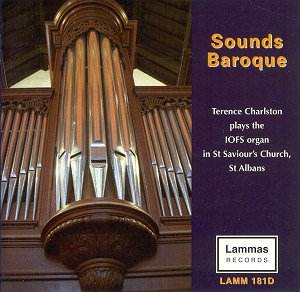
Sounds
Baroque
Georg MUFFAT (1653-1704)
Toccata Secunda [5:41]
Henry
PURCELL (1659-1695)
Voluntary in G [3:11]
François
COUPERIN (1668-1733)
Kyries, (Messe pour
les Paroisses):
Plein chant du premier Kyrie, en Taille [1:15]; Fugue sur les jeux d’anches
[2:06]; Recit de Cromhorne [2:21]; Dialogue sur la trompette et le Cromhorne
[1:50]; Plein chant [1:11]
Johann
Sebastian BACH (1685-1750)
Allein Gott
in der Hőh sei Ehr BWV
663 [6:42]
Toccata and Fugue
in D minor BWV
538: Toccata [5:19]; Fugue [7:50]
Jesu, meine Freude
BWV 753 (completed
Charleston) [2:29]
Johann
Philipp KIRNBERGER
(1721-1783)
Ich dank dir
schon [2:10]
J.S. BACH
Herr Jesu Christ,
dich zu uns wend BWV
709 [2:49]
Georg
BÖHM (1661-1733)
Prelude and
Fugue in C major:
Prelude [2:02]; Fugue [2:37]
J.S. BACH
Komm, Gott,
Schöpfer, Heiliger Geist BWV
667 [2:36]
François
COUPERIN
Benedictus Cromhorne
en Taille (Messe pour les Parroisses) [4:05]
Carl Phillip
Emanuel BACH (1714-1788)
Sonata in A Wq
70/4: Allegro Assai [4:43]; Adagio [3:16]; Allegro [3:18]
J. KIRNBERGER
Musical Circle
[3:23]
John STANLEY
(1712-1786)
Voluntary
op. 7 No. 7: Diapasons Adagio [1:54];
Cornet [2:30];
Voluntary op. 7 No. 9: Largo staccato [1:01]; Vivace [2:41]
![]() Terence Charleston, organ
Terence Charleston, organ
Rec: St Saviour:s Church,
St Albans, 11-12 September, 10 October 2004. DDD
![]() LAMMAS
LAMM 181D [79:11]
LAMMAS
LAMM 181D [79:11]
AVAILABILITY






